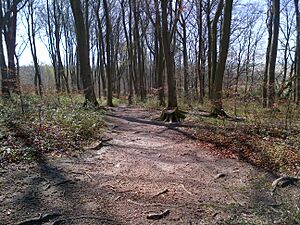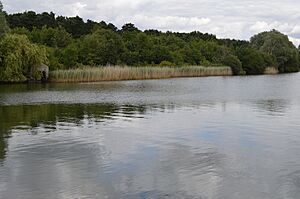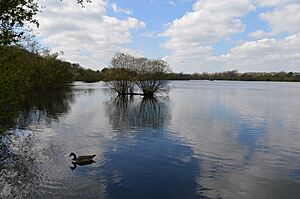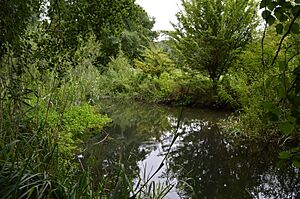Herts and Middlesex Wildlife Trust facts for kids
 |
|

The entrance to Hexton Chalk Pit, near Hitchin
|
|
| Formation | October 9, 1964 |
|---|---|
| Type | Conservation charity |
| Registration no. | Registered charity 239863 |
| Headquarters | St Albans, Hertfordshire |
|
Region
|
Hertfordshire, parts of North London |
|
Chief Executive
|
Lesley Davies |
|
Main organ
|
Local Wildlife Sites Newsletter |
|
Parent organization
|
The Wildlife Trusts |
|
Formerly called
|
Hertfordshire & Middlesex Trust for Nature Conservation |
The Herts and Middlesex Wildlife Trust is a special group that works to protect nature and wildlife. They look after more than 40 nature reserves. These places cover a huge area of land, almost 810 hectares (2,000 acres), north of London. You can find them in Hertfordshire and parts of Middlesex, which includes areas like Barnet, Enfield, Harrow and Hillingdon.
This Trust is part of a bigger family of 46 Wildlife Trusts across the UK. It has over 21,000 members who care about nature. The Trust is a registered charity, which means it's a non-profit organization that helps the community. Its main office is in St Albans.
The Trust does many important things. They manage nature reserves to make sure animals and plants have safe homes. They also give advice to landowners on how to look after their land for wildlife. When new buildings are planned, the Trust shares its ideas to help protect nature. They also encourage people to volunteer and help maintain these beautiful nature spots.
The idea for the Trust started in 1963, and it officially began on October 9, 1964. Back then, it was called the Hertfordshire & Middlesex Trust for Nature Conservation. By 1970, they were already looking after twenty reserves! That same year, they started managing Blagrove Common, which is a very important wildlife site. In 1987, they changed their name to the Herts and Middlesex Wildlife Trust. A big achievement was in 2007 when they bought Amwell Quarry. They worked hard to restore it, and now it's a super important place for wetland birds from all over the world.
Some of the Trust's nature reserves are so important that they are called Ramsar sites. These are internationally recognized wetland areas. Fifteen of their sites are SSSIs, which means they are very special for their wildlife or geology. Five are also Local Nature Reserves, which are important for local people and wildlife. The very first place they looked after was Fox Covert, given to them in 1964. The biggest reserve is King's Meads, which is 96 hectares (240 acres) of water meadows. It's home to 265 types of wildflowers and is a key spot for stonechats in winter. The smallest reserve is Alpine Meadow, which is only 0.8 hectares. It's a special example of rare chalk grassland.
Nature Reserves to Explore
Understanding the Symbols
|
|
| Site Name | Photo | Size | Location | Public Access | Special Status | What Makes it Special |
|---|---|---|---|---|---|---|
| Aldbury Nowers | 19.7 ha (49 acres) | Tring 51°48′45″N 0°37′11″W / 51.8125°N 0.6197°W |
YES | SSSI | This site has some of the best chalk grasslands and ancient woodlands in the area. | |
| Alpine Meadow | 0.8 ha (2.0 acres) | Berkhamsted 51°46′59″N 0°34′01″W / 51.7831°N 0.5670°W |
YES | SSSI | A rare, steep meadow with special chalk grassland. Look for beautiful butterflies like the marbled white and the rare Duke of Burgundy. | |
| Amwell Quarry | 40.1 ha (99 acres) | Amwell 51°47′47″N 0°00′19″W / 51.7965°N 0.0053°W |
YES | SSSI Ramsar SPA | This old gravel pit is super important for birds that spend winter here. You can also spot many types of dragonflies. | |
| Ashwell Quarry and Quarry Springs | 3.0 ha (7.4 acres) | Ashwell 52°02′25″N 0°10′26″W / 52.0402°N 0.1738°W |
PO | RIGS | The quarry has unique plants like pyramidal orchids. The springs are home to rare flatworms that need very clean, cool water. | |
| Balls Wood | 58.5 ha (145 acres) | Hertford Heath 51°46′41″N 0°02′49″W / 51.778°N 0.047°W |
YES | This wood has open grassy paths where many butterflies fly in spring. Keep an eye out for Great spotted woodpeckers and sparrowhawks. | ||
| Blagrove Common | 3.9 ha (9.6 acres) | Sandon 51°59′11″N 0°04′00″W / 51.9863°N 0.0668°W |
YES | SSSI | A rare marshy grassland with many types of orchids, cuckoo flowers, and marsh marigolds. | |
| Broadwater Lake | 19.4 ha (48 acres) | Harefield 51°35′07″N 0°29′33″W / 51.5852°N 0.4924°W |
YES | SSSI | This reserve is part of a nationally important bird area. You might see great crested grebes and cormorants. | |
| Cassiobury Park | 24.6 ha (61 acres) | Watford 51°39′49″N 0°25′34″W / 51.6635°N 0.4262°W |
YES | LNR | A corner of the park with marshland, pools, and wet woodland. It's a great spot for many bird species to breed and find food. | |
| Danemead | 5.6 ha (14 acres) | Hoddesdon 51°45′08″N 0°03′03″W / 51.7523°N 0.0507°W |
YES | SSSI | This site has wet grassland, scrub, and woodland with a stream. Look for wild flowers like meadowsweet. | |
| Fir and Pond Woods | 29.0 ha (72 acres) | Potters Bar 51°41′44″N 0°09′11″W / 51.6955°N 0.1530°W |
YES | These woods are old remnants of Enfield Chase. They offer diverse habitats like woodland, meadows, and wetlands, with many different birds. | ||
| Fox Covert | 2.9 ha (7.2 acres) | Royston 52°02′24″N 0°03′21″W / 52.0401°N 0.0557°W |
YES | A mature beech woodland planted in the 1800s. You can find many white helleborine orchids, deer, and various bird species here. | ||
| Frogmore Meadow | 3.3 ha (8.2 acres) | Chenies 51°40′45″N 0°31′21″W / 51.6791°N 0.5225°W |
YES | SSSI | This SSSI has marshy areas and fens next to the River Chess. Keep an eye out for water voles along the river bank. | |
| Gobions Wood | 36.0 ha (89 acres) | Brookmans Park 51°43′17″N 0°11′33″W / 51.7213°N 0.1925°W |
YES | Mainly woodland, but also has grasslands, hedges, and ponds. Over 550 types of fungi have been found here! Birds like blackcaps and nuthatches are common. | ||
| Hawkins Wood | 10.0 ha (25 acres) | Therfield 51°59′52″N 0°03′06″W / 51.9978°N 0.0517°W |
YES | This wood has ancient banks and ditches. You can see birds like bullfinches and yellowhammers, plus brown hares and deer. | ||
| Hertford Heath | 28.3 ha (70 acres) | Hertford Heath 51°46′48″N 0°02′32″W / 51.7800°N 0.0423°W |
YES | SSSI | A rare example of heathland, dominated by heather. Look for grass snakes and slowworms. | |
| Hexton Chalk Pit | 1.9 ha (4.7 acres) | Hexton 51°57′25″N 0°23′23″W / 51.9570°N 0.3897°W |
YES | This old chalk quarry has beautiful grassland with many chalk-loving plants and five types of orchids. It's home to a large group of chalkhill blue butterflies. | ||
| Hilfield Park Reservoir | 76.3 ha (189 acres) | Bushey 51°39′04″N 0°20′10″W / 51.651°N 0.336°W |
WTO | LNR | A large reservoir important for wintering birds like pochards and tufted ducks. Many marsh plants grow along its edges. | |
| Hunsdon and Eastwick Meads | 28.0 ha (69 acres) | Harlow 51°46′33″N 0°02′56″E / 51.7758°N 0.0488°E |
YES | SSSI | This SSSI is an old grassland that floods in winter. It's managed using a very old hay-making method. | |
| King's Meads | 96.0 ha (237 acres) | Ware 51°48′18″N 0°02′38″W / 51.805°N 0.044°W |
YES | These water meadows often flood in winter, attracting many water birds. It's a key spot for stonechats in the colder months. | ||
| Lemsford Springs | 4.0 ha (9.9 acres) | Lemsford 51°47′47″N 0°13′43″W / 51.7964°N 0.2287°W |
PO | This site has lagoons fed by springs, so they never freeze. This makes it a vital home for birds in winter. You might see water rails and snipe. | ||
| Long Deans | 15.0 ha (37 acres) | Nash Mills 51°43′52″N 0°26′39″W / 51.7312°N 0.4441°W |
YES | This reserve has grasslands and woodlands with old trees. The ancient trees are home to fungi, birds, and bats. | ||
| Longspring Wood | 1.2 ha (3.0 acres) | Kings Langley 51°43′12″N 0°25′17″W / 51.7201°N 0.4213°W |
YES | A small wood with oak, ash, and wild cherry trees. In spring, you'll see a beautiful display of bluebells. Foxes and badgers live here too. | ||
| Old Park Wood | 7.7 ha (19 acres) | Harefield 51°36′40″N 0°29′09″W / 51.6112°N 0.4857°W |
YES | SSSI | This SSSI is one of the richest ancient woods in Greater London for plants. It's on a steep slope and supports many breeding birds. | |
| Oughtonhead | 6.2 ha (15 acres) | Hitchin 51°57′37″N 0°17′58″W / 51.9602°N 0.2994°W |
NO | This reserve has wet and dry woodlands, a river bank, and fen areas. You might spot kingfishers and water rails, as well as water shrews. | ||
| Patmore Heath | 8.4 ha (21 acres) | Albury 51°54′42″N 0°05′39″E / 51.9116°N 0.0943°E |
YES | SSSI | Mostly dry heathland, but some areas have pools and marshes with unique wetland plants. It's also known for insects like the emperor dragonfly. | |
| Purwell Ninesprings | 6.4 ha (16 acres) | Hitchin 51°56′59″N 0°14′45″W / 51.9496°N 0.2459°W |
YES | This site has open water with water voles and birds like moorhens and mallards. The wet ground is home to plants like yellow iris. | ||
| Ridlins Mire | 1.6 ha (4.0 acres) | Stevenage 51°53′04″N 0°09′56″W / 51.8845°N 0.1656°W |
NF | A unique wetland site formed by a spring, creating a rare domed peat structure. You can find long-tailed tits and butterflies like small tortoiseshells here. | ||
| Rye Meads | 32.0 ha (79 acres) | Rye House 51°46′29″N 0°00′45″E / 51.7746°N 0.0126°E |
YES | SSSI Ramsar SPA | An ancient flood meadow with reedbeds and marshy grasslands. Ponies and water buffalo graze here. Look for water rails and grass snakes. | |
| Stanborough Reedmarsh | 3.3 ha (8.2 acres) | Welwyn Garden City 51°46′48″N 0°13′04″W / 51.7801°N 0.2177°W |
YES | LNR | Wet willow woodland along the River Lea. It's important for water voles and birds like reed and sedge warblers. | |
| Stocker's Lake | 40.4 ha (100 acres) | Rickmansworth 51°38′05″N 0°29′06″W / 51.6346°N 0.4850°W |
YES | LNR | This large lake is nationally important for its wintering birds, including goldeneye and smew. It has the biggest heronry in Hertfordshire. | |
| Stocking Springs Wood | 1.1 ha (2.7 acres) | Ayot St Lawrence 51°49′32″N 0°15′18″W / 51.8256°N 0.2551°W |
YES | This woodland has old hornbeam trees. In spring, you'll see bluebells and wild daffodils, showing it's an ancient woodland. | ||
| Tewin Orchard and Hopkyns Wood | 4.3 ha (11 acres) | Tewin 51°49′27″N 0°09′39″W / 51.8242°N 0.1608°W |
YES | Tewin Orchard is an 80-year-old fruit orchard with special local apple types. It attracts many birds like fieldfares. Hopkyns Wood has old oaks and a badger sett. | ||
| Tewinbury | 3.6 ha (8.9 acres) | Tewin 51°49′27″N 0°09′39″W / 51.8242°N 0.1608°W |
VO | SSSI | This SSSI has rare wet meadows and marshes. You might even spot otters along the riverbank! | |
| Thorley Wash | 13.0 ha (32 acres) | Thorley 51°50′32″N 0°09′39″E / 51.8421°N 0.1607°E |
YES | SSSI | This site has rare tall wash grassland, marsh, and waterlogged areas. It's home to many different plant species. | |
| Tring Reservoirs | 55.0 ha (136 acres) | Tring 51°48′43″N 0°41′20″W / 51.812°N 0.689°W |
YES | SSSI | These reservoirs are important for birds and insects, including many different types of dragonflies. | |
| Uxbridge Alderglade | 2.9 ha (7.2 acres) | Uxbridge 51°33′26″N 0°28′34″W / 51.5571°N 0.4760°W |
YES | This old railway embankment has wet woodland and marsh areas. You might find rare Brandt's bats, stoats, and weasels here. | ||
| Waterford Heath | 35.2 ha (87 acres) | Waterford 51°49′07″N 0°05′19″W / 51.8185°N 0.0885°W |
YES | LNR | This old quarry has grasslands, scrub, and woodland. Look for breeding birds like skylarks and reptiles such as slowworms and grass snakes. | |
| Willowmead | 1.5 ha (3.7 acres) | Hertford 51°47′33″N 0°05′43″W / 51.7926°N 0.0954°W |
YES | This site is wet woodland along the River Mimram. You might see water voles, otters, and kingfishers in the river. |
Images for kids













































































